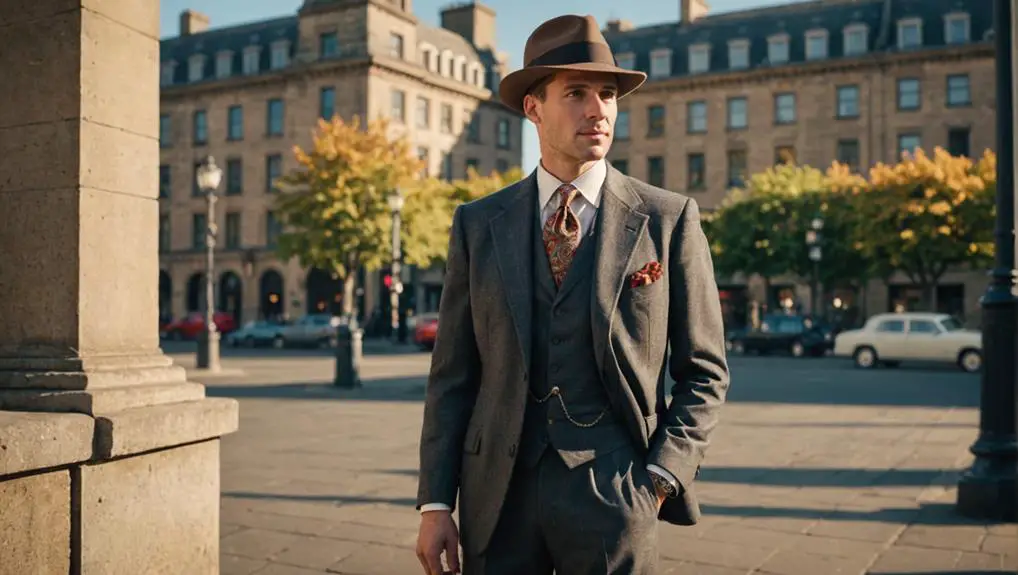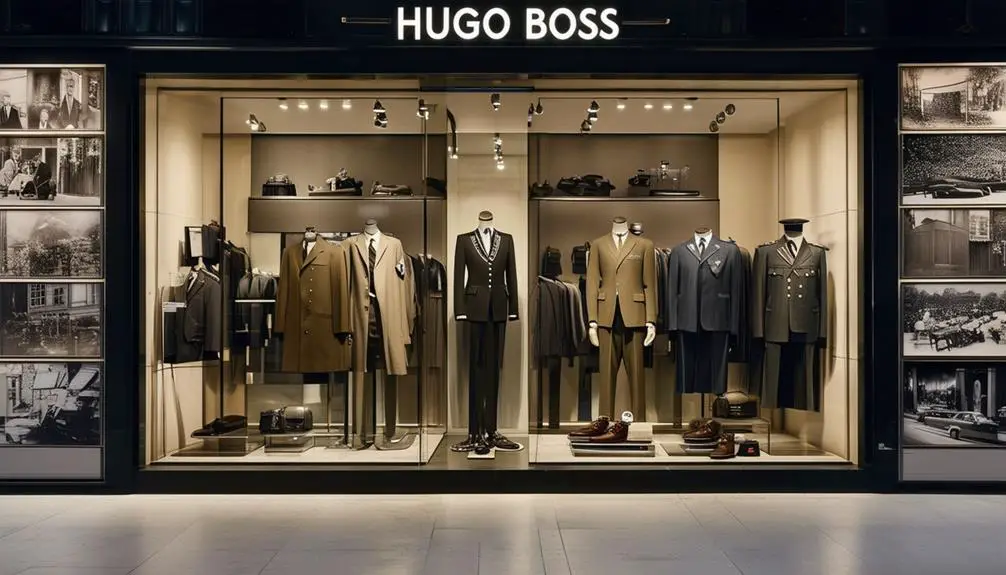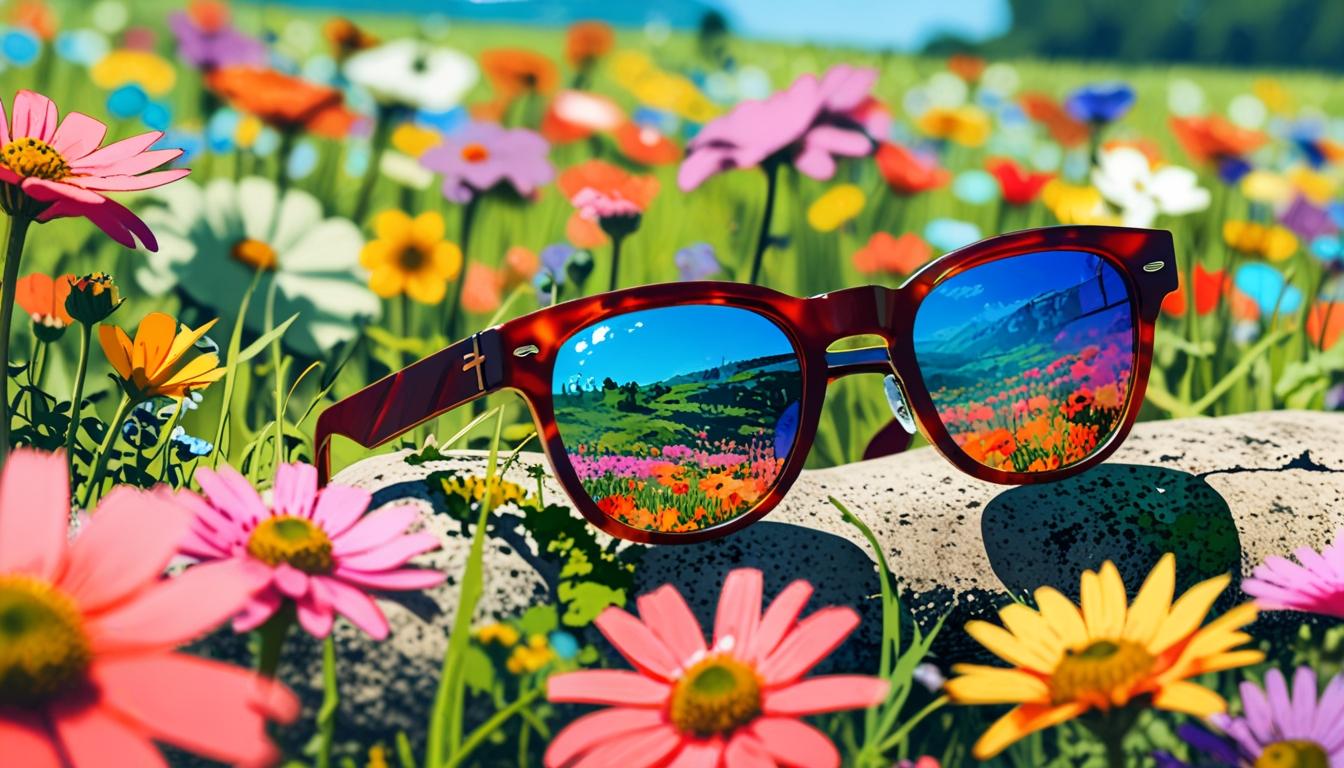Men's cravats in the 1940s were more than just accessories; they were symbols of style and individuality. You'd find these luxurious pieces crafted from silk, rayon, or satin, showcasing vibrant colors and intricate patterns, often influenced by the Art Deco movement. The bold designs and varying widths, some reaching up to 4.25 inches, made a statement in both formal and casual settings. As post-World War II fashion evolved, cravats became essential for making lasting impressions. Their significance rooted in elegance reflects broader trends of the era, hinting at the rich narrative behind each piece and its cultural impact.
Historical Significance of Cravats

The cravat, once a staple of 17th-century fashion, found renewed significance in the 1940s as it became emblematic of a transformative era in menswear. During this decade, the cravat evolved from a formal accessory to a versatile piece that complemented casual attire, allowing men to express their individuality. Made from luxurious materials like silk, these vintage ties showcased intricate patterns and vibrant colors, heavily influenced by the Art Deco movement. Vintage clothing identification became essential for enthusiasts seeking to appreciate the craftsmanship and historical context behind these accessories.
This shift in fashion coincided with a post-World War II cultural landscape, where elegance and sophistication became crucial for the modern gentleman. The cravat represented not just style but also a historical narrative, capturing the essence of a society recovering from turmoil. Its presence in films and popular culture further solidified its status, making it a symbol of refinement amidst a changing world.
Today, collectors value 1940s cravats for their aesthetic appeal and historical significance. Each piece reflects a period marked by innovation and creativity in menswear, highlighting how the cravat transcended its origins to embody a new era of fashion, bridging tradition with modernity.
Popular Fabrics and Materials
Cravats in the 1940s featured a range of luxurious fabrics that not only enhanced their aesthetic appeal but also reflected the era's evolving fashion sensibilities. The materials used in these cravats played a vital role in defining men's style during this transformative decade.
- Silk: Renowned for its smooth finish and vibrant hues, silk cravats were highly coveted, especially hand-painted versions that showcased unique artistry.
- Rayon: Emerging as a popular alternative to silk due to wartime rationing, rayon offered a cost-effective yet stylish option, allowing more men to embrace fashionable neckwear.
- Satin: This fabric provided a glossy look that added sophistication, making satin cravats a staple for formal occasions.
- Jacquard Weaves: The intricate patterns and textures of jacquard weaves contributed remarkably to the visual appeal of cravats, reflecting the bold fashion trends of the time.
Vintage cravats from this period often featured striking colors and playful designs, embodying both elegance and a sense of individuality. By choosing these fabrics, men not only expressed their style but also adapted to the changing landscape of fashion in the 1940s.
Price Range of Vintage Cravats
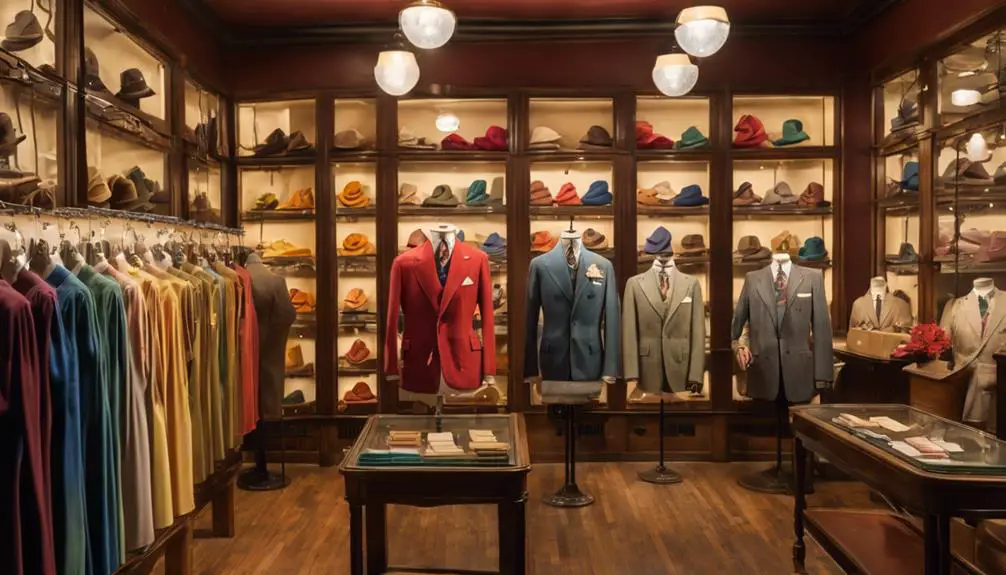
Vintage cravats from the 1940s offer a fascinating glimpse into the era's fashion landscape, and their prices reflect both their historical significance and unique characteristics. If you're venturing into the world of vintage style, you'll find that the price range for these cravats varies widely. Lower-end options might start around $6.49, while higher-end pieces can exceed $96.00.
Here's a breakdown of some price points you might encounter:
| Cravat Type | Price | Shipping Cost |
|---|---|---|
| Authentic Croylon cravat | $10.00 | Free |
| Vintage Hollyvogue cravat | $74.95 | Free |
| Unique hand-painted designs | $49.95 | Free |
| Wilson Brothers skinny swing tie | $96.00 | Best Offer |
| Mens Necktie Unbranded Maroon | $6.49 | $3.96 – $5.95 |
When purchasing online, keep shipping costs in mind as they can add to your total expense. Collectible or rare designs often demand higher prices, making them valuable additions to any wardrobe.
Unique Design Features
During the 1940s, men's cravats showcased a fascinating blend of artistic expression and sophisticated design elements that truly set them apart. These accessories weren't just about function; they were a canvas for creativity. You'd often find unique features that made each piece a declaration of style and individuality.
Key design features included:
- Hand Painted Patterns: Many cravats featured intricate, hand-painted designs that added a personal touch.
- Luxurious Materials: Silks and rayon satins created a smooth texture, elevating the overall look of the vintage tie.
- Art Deco Motifs: Designs incorporated abstract shapes and vivid color palettes, echoing the popular Art Deco movement.
- Unique Embellishments: Some regal cravats included filigree-set gems, adding an exclusive elegance that drew attention.
These elements combined to create cravats that were not only fashionable but also reflective of the artistic trends of the era. With bold contrasts and surrealistic prints, these pieces became essential for those looking to make a declaration at formal occasions. Each silk cravat you encountered was a reflection of the creativity and craftsmanship of the time, marking a distinctive chapter in men's fashion history.
Styles and Patterns of the Era
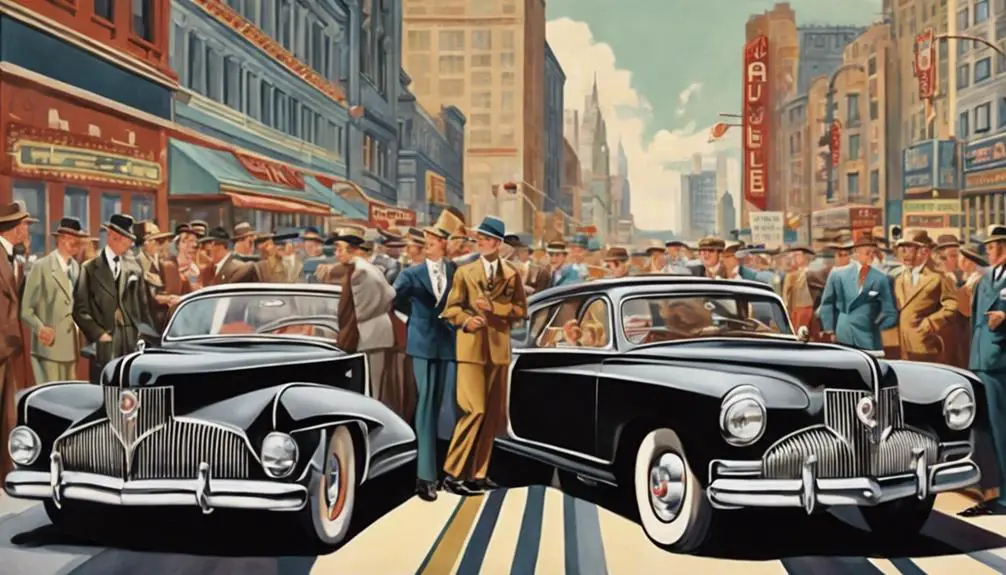
The 1940s marked a vibrant period for men's fashion, particularly in the domain of cravats, where style and individuality flourished. You'd notice the era's cravats, showcasing a range of unique designs that included geometric patterns and hand-painted silk options. Abstract prints dominated the scene, reflecting the artistic trends that inspired the decade. Vivid colors, like deep reds, blues, and yellows, contrasted beautifully against darker backgrounds, making bold statements.
Cravats made from luxurious rayon satin and silk became popular, often embellished with intricate patterns such as atomic squares, floral motifs, and zig-zag accents. These vintage mens necktie unbranded pieces presented a sense of sophistication and creativity, perfectly complementing tailored suits of the time. Widths varied, with some cravats reaching up to 4.25 inches, allowing you to express your personality through your accessory choices.
Moreover, the versatility of 1940s cravats made them suitable for both formal events and casual outings. This adaptability highlighted how essential these accessories were for men looking to make a lasting impression, blending style with function seamlessly in a transformative era.
Collectible Cravats and Ties
Collecting cravats and ties from the 1940s has become a fascinating pursuit for enthusiasts and fashion historians alike, with prices reflecting their desirability and rarity. The vintage market for these pieces is thriving, thanks to their unique historical significance and aesthetic appeal. For instance, you might find a Pilgrim cravat for as low as $6.49, while rarer items like the Wilson Brothers skinny swing tie can soar above $96.
When exploring collectible cravats, consider the following features that enhance their value:
- Unique hand-painted designs or rare patterns
- Distinctive prints, such as the 1940s vintage Cheney cravat with bird plumage, priced around $27.99
- Availability of shipping discounts or best offers to make purchases accessible
- The resurgence of interest in vintage mens neck ties, including red ties, which amplifies their appeal
As you immerse yourself in this collectible domain, keep an eye out for these unique characteristics. They not only enrich your collection but also connect you to the fashion narratives of the 1940s, making every piece a conversation starter.
Fashion Trends in the 1940s
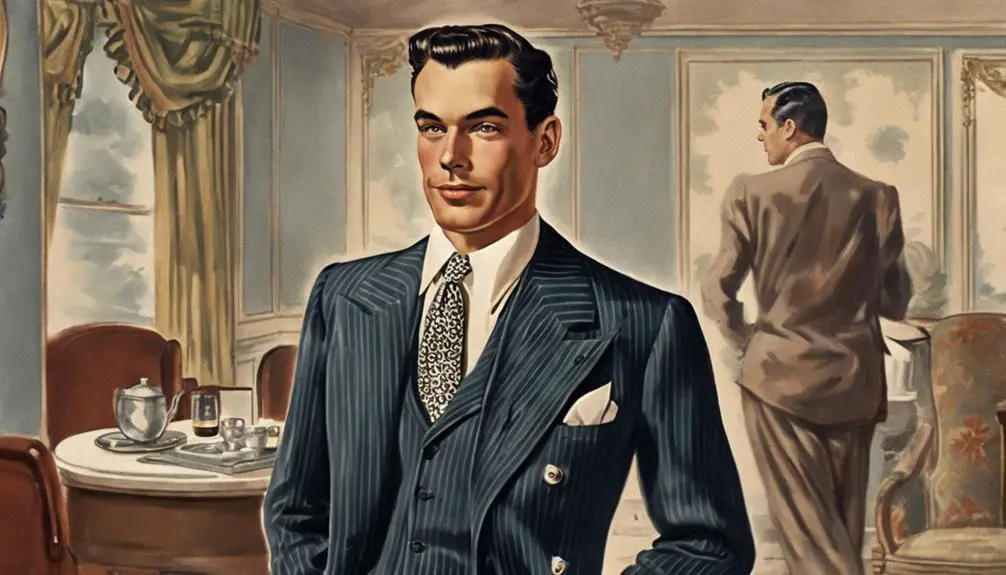
Cravats weren't just a collectible in the 1940s; they were emblematic of the era's broader fashion trends that embraced individuality and flair. During this time, men's fashion welcomed a resurgence of cravats, often chosen as a stylish alternative to the more conventional silk ties. This decade thrived on self-expression, and cravats played a crucial role in that narrative.
Typically made from luxurious fabrics like silk and rayon, these cravats showcased bold patterns and rich colors that echoed the Art Deco and Abstract styles. You'd find geometric designs and hand-painted motifs that appealed to your desire for uniqueness. The width of cravats varied, with some reaching up to 4.25 inches, creating a dramatic contrast against the structured silhouettes of tailored suits.
Incorporating a cravat into your ensemble added sophistication to both casual and formal outfits, perfectly aligning with the prevailing fashion trends. It wasn't merely an accessory; it was a statement piece that reflected the dynamic and evolving nature of men's fashion in the 1940s. Embracing these vibrant designs allowed you to stand out, fully embodying the era's spirit of creativity and self-assuredness.
Accessories Complementing Cravats
To enhance the sophistication of your ensemble, accessories like pocket squares and cufflinks were essential companions to cravats in the 1940s. These elements not only accentuated your cravat but also reflected your attention to detail and personal style.
Consider the following accessories to elevate your look:
- Pocket Squares: A crisp, folded pocket square adds a dash of color and flair, harmonizing beautifully with your cravat.
- Cufflinks: These small yet striking accessories offer a polished finish to your shirt cuffs, drawing attention to your overall ensemble.
- Collar Bars: Using a collar bar keeps your collar crisp while ensuring your cravat sits perfectly underneath, providing a sleek appearance.
- Vintage Pocket Watches: These timepieces serve as functional yet stylish accents, enhancing the classic aesthetic of your outfit.
Additionally, trilby hats or fedoras paired well with cravats, adding a fashionable touch. Functional accessories like tie bars and suspenders were also popular, maintaining the cravat's position and enhancing trouser fit. By thoughtfully selecting these accessories, you showcase a refined approach to 1940s men's fashion, ensuring your cravat remains the focal point of your attire.
Notable Brands of Cravats
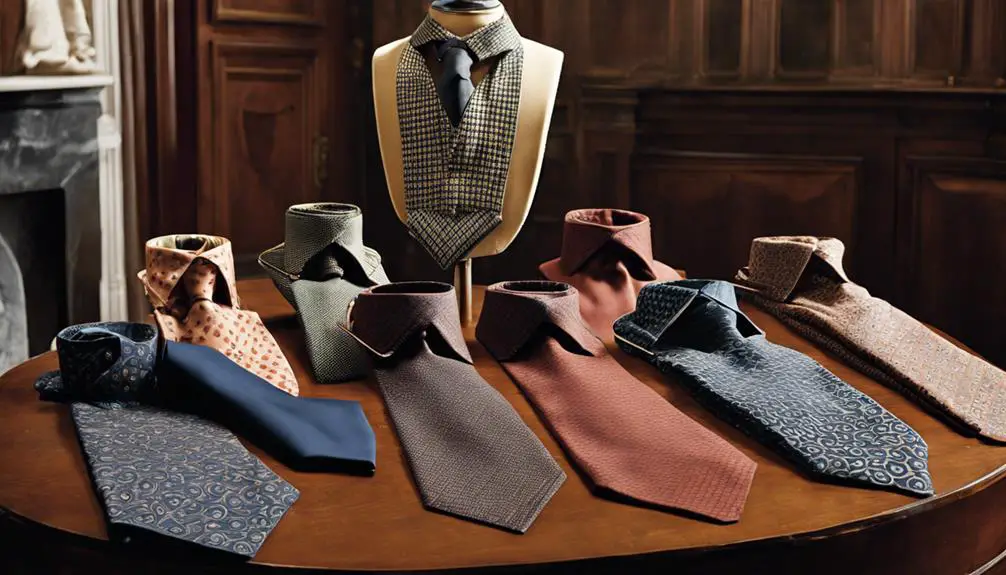
In the vibrant landscape of 1940s fashion, several notable brands emerged as leaders in cravat design, each contributing unique flair and quality to men's accessories. Among these, Pilgrim stood out with its bold and artistic prints. Their cravats often featured vibrant colors and intricate patterns, perfectly capturing the era's expressive aesthetic. You'd find that wearing a Pilgrim cravat made a statement, reflecting a spirit of creativity and individuality.
Superba, on the other hand, catered to a more sophisticated clientele, known for its luxurious materials and meticulous attention to detail. These cravats exuded elegance and refinement, appealing to gentlemen who sought to elevate their wardrobe with high-quality accessories.
Then there's Hollyvogue, which distinguished itself through fashionable styles that frequently incorporated contemporary design elements. Their cravats resonated well with the current trends of the time, allowing wearers to stay stylishly relevant.
Today, vintage cravats from these brands are highly sought after by collectors, often fetching prices ranging from $10 to over $100, depending on rarity and condition. Each brand's legacy continues to influence men's fashion long after the 1940s.
Care and Maintenance Tips
Maintaining the elegance of vintage cravats requires careful attention to their unique materials and craftsmanship. These accessories often feature delicate fabrics like silk and rayon, making their care essential to preserving their beauty and longevity. Here are some key tips to guarantee your cravats remain in pristine condition:
- Dry clean: Always opt for dry cleaning instead of washing in water. This prevents damage to the fabric.
- Store cravats: Keep your cravats flat or rolled in a cool, dry place. This helps avoid creases and maintains their shape.
- Avoid sunlight: Steer clear of exposing cravats to direct sunlight for extended periods, as UV rays can fade their vibrant colors.
- Iron cravats: If necessary, iron your cravats on a low heat setting, placing a cloth between the iron and fabric to prevent scorching.
Frequently Asked Questions
When Did Men Start Wearing Cravats?
Men started wearing cravats in the 17th century, gaining popularity throughout Europe. You'll notice they evolved into various styles, especially by the 18th century, cementing their place in men's fashion history.
Did Men Wear Cravats in the 1950s?
Yes, men wore cravats in the 1950s, often pairing them with suits for formal occasions. These accessories became more streamlined, featuring muted colors and geometric patterns, reflecting the minimalist style that defined the decade.
Which Men's Fashion Style Became Very Popular in the 1940s?
In the 1940s, sharp tailoring became your go-to fashion style. You embraced broad-shouldered suits and high-waisted trousers, often accessorizing with vibrant ties or cravats, enhancing your sophisticated and polished appearance for both formal and casual occasions.
What Accessories for Men Played an Important Part of Fashion in the 1940s?
In the 1940s, accessories like ties, pocket squares, and cufflinks were essential for men's fashion. These elements enhanced tailored suits, adding personality and flair, while hats completed the polished look that defined the era.
